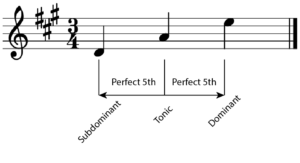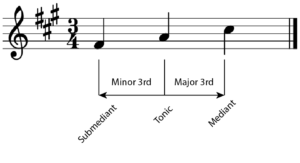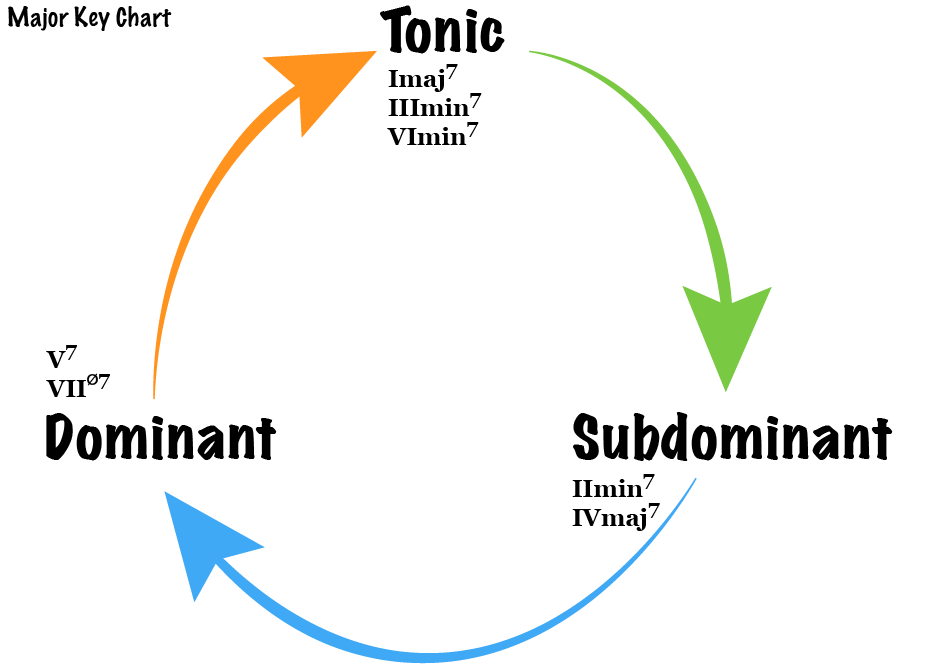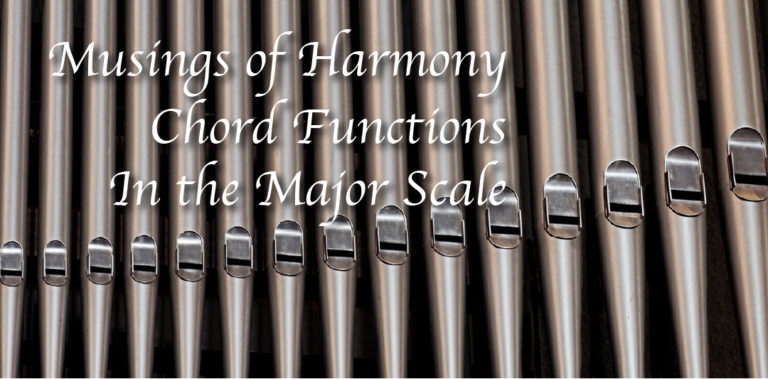When we want to talk about the functions of chords and functional harmony, there are some things that we need to understand first.
Chord functions and in this particular case diatonic functions are a theoretical way to understand why things move or flow in a particular way in music. It gives us some ways to explain why certain chord patterns work well and others don’t.
We need to understand the grades of the most common scales: the major scale and the minor scale.
Grades play an important part in understanding the chord functions. Chords are a collection of grades and so it makes sense that to understand the motion of chords we need to understand the motion of the individual grades.
It does need to be said though that this is all very subjective and bound by style and cultural background among others.
Grades of the Major Scale
When we give each note of a scale in ascending order a number, those numbers represent the grades of the scale.
Grades are useful to generalize or normalize scales in any key. The first note of A major will be the first degree of A major and the first note of Bb major will be the first degree of Bb major.
Even though they represent different notes A and Bb, these notes perform the same function in their respective major scales.
Thinking in grades rather than absolute note names gives us the opportunity to explain music theory while remaining oblivious to any given key.
Naming the Grades of the Major Scale

Tonic
The first degree is called the TONIC or the KEYNOTE. It gives the major scale its name. The tonic provides rest in the scale, it is the tone where it feels like the melody is arriving home.
Supertonic
The SUPERTONIC is not the tonic with superpowers nor is it something you drink to get superpowers… It is the second degree of the scale and the name SUPER comes from Latin and means ABOVE, in other words, it is the grade above the tonic.
Mediant
The name of the third degree is MEDIANT. The name comes from Latin and roughly translates to MIDDLE. It was given this name because it sits in the middle of the tonic and the dominant. The mediant is important to the scale since it gives the scale its character; minor or major.
Subdominant

One would think the name of the fourth degree, the SUBDOMINANT, gets its name because it is one note below the dominant, but that is in fact not entirely correct. The real reason for the name is that when placed below the tonic it has the exact same interval distance to the tonic as the dominant has when placed above the tonic.
Dominant
The DOMINANT positioned at the fifth degree is called this way due to its very powerful relation towards the tonic. We will go deeper into this when we talk about the function of the dominant chord. What you can remember for now is that the dominant often dominates the harmony of a song.
Submediant

The name of the SUBMEDIANT on the sixth degree follows the same reasoning as the subdominant. When placed below the tonic it has the same interval distance as the mediant placed above the tonic. This time it is not the exact same, both are thirds, but the one is minor and the other is major.
Leading Tone
The LEADING TONE on the seventh degree gets its name because it has the strongest pull towards the tonic. In other words, it leads us back to the tonic. In scales where the 7th degree is lowered, we call this grade the SUBTONIC instead. The minor scale is an example of this as we will learn later.
Grade Tendencies Against the Tonic
In general, we could say that the grades which create the most tension are those that are a minor 2nd interval away from any of the notes in the root Tonic chord which has the formula 1 – 3 – 5.
The grades that fit that description are the SUBDOMINANT and the LEADING TONE.
Chord Functions – Functional Harmony
In modern, contemporary music theory we distinguish three groups or functions of chords: Tonic, Subdominant and Dominant. The Subdominant function is also often called Pre-Dominant.
Let’s define the three functions for diatonic chords.
These definitions are specific for 7th chords or tetrads. By dropping the 7th note from the tetrad you will get the triads with the same function. If you perform these definitions with Triads in mind you will not get the correct results.
Tonic Chords
Tonic chords are those chords on the diatonic scale that do not contain the 4th degree as a chord note.
For the major scale, this means: Imaj7, IIImin7 and VImin7
Example of Tonic Chords in D Major

Subdominant Chords (Pre-dominant)
The Subdominant chords are the chords on the diatonic scale that contain the 4th degree as a chord note, but not the 7th degree.
For the major scale, these are: IImin7 and IVmaj7
Example of Subdominant Chords in D Major

Dominant Chords
The Dominant chords are those chords on the diatonic scale that contain the 4th degree and the 7th degree as chord notes.
For the major scale, those are: V7 and VIIø7 (half diminished)
Example of Dominant Chords in D Major

Chord Tendency and Progression
This is where things get really interesting. Remember, at the start of this article I mentioned that chords are a collection of scale grades. The tendency of a chord is the combination of all tendencies of its individual grades.
Granted that all of that is rather subjective, centuries of musical evolution have somewhat imprinted a certain level of expectation into those with a Western social and cultural background.
Tonic Chords Bring Repose, Resolve, Rest
Most Western music, be it classical or modern, is written in such a way that it provides a certain build-up of tension that makes the listener yearn for some form of release; a resolution to the tonic.
The tonic chords of a scale are the chords that provide stability in the song. It gives the listener a chance to breathe, to orientate and align with the scale.
We saw earlier that for a major scale, Imaj7, IIImin7 and VImin7 are the tonic chords.
For two of those chords it is relatively clear why they are tonic chords, for one it is not so clear:
- Imaj7 with scale degrees 1, 3, 5 and 7 is very clear since it is the root chord.
- VImin7 with scale degrees 6, 1, 3 and 5 has degree 1, 3 and 5 in common with the root chord, so when played with the 1st degree in the bass this results in a I6 chord.
- IIImin7 with scale degrees 3, 5, 7 and 2 is not so clear because it is missing the 1st degree. However, it has 3, 5 and 7 in common, so if we add the 1st degree as a base note, we end up with a Imaj9 chord and thus acts as a tonic chord.
Worthy to note that all three chords have the 3rd and the 5th degree of the scale in common.
Subdominant Chords Are Going Places
Subdominant chords aka pre-dominant chords allow us to move away from the tonic. They don’t give us a feeling of full repose, but they also don’t give that much tension that we would yearn for a resolution.
I like to see the subdominant chords as the story spinners… The main character is leaving the safety of home but is not yet getting into any trouble 🙂
There is not much tension in the subdominant chords and there is not much pull to any particular side. Both subdominant chords have the subdominant degree as a chord note which creates some tension but not enough to create a pulling feeling. Also, a perfect 4th against the tonic degree is actually a very pleasant interval to listen to.
The 4th degree only has a pull toward the mediant (3rd) degree, but that resolution is easily presented within both of the subdominant chords since IVmaj7 has the 3rd degree as a chord note and IImin7 can be played as a IImin9 chord where the 9 delivers the 3rd degree of the scale.
Dominant Chords Pull Us Back Home
The dominant chords introduce a lot of tension, the tension that screams for resolution. Our main character is in trouble… Maybe he is in love yearning for his lovers embrace?
The presence of the 4th and the 7th degree in dominant chords causes a strong pull towards the tonic and the mediant and as we have learned, the tonic and mediant degrees are typical for Tonic chords.
What is more, the interval between the 4th and 7th degree is a tritone which has so much tension that it begs to be resolved.
Dominant chords yearn for resolution, but that doesn’t mean that they have to resolve… Often it is very nice to build up an expectation to a resolution but instead keep up the tension and surprise the listener.
Often it is the delay of the resolution that makes songs interesting… But that is what functional harmony is all about. We know what the listener expects and so we know that we can break those rules to make our music really interesting and appealing.
Common Function Cycle for Chord Progressions

When we look at traditional harmony and the most common chord progressions or cadence patterns we find that they move through these groups in the order as shown on the image above.
Let’s have a look at some of the most common and popular progressions to illustrate this.
Common Chord Progressions
I – IV – V
Probably the most common progression in loads of styles is the “1 – 4 – 5” progression. It is used in Jazz, Blues, Rock, Reggae, Pop, Country, Folk…
It is most commonly used as a “I – IV – V – I” To complete the cadence at the end.
Example: Reggae in I – IV – V
This is a very simple example to demonstrate how a I – IV – V would sound in a Reggae song.
II – V – I
In Jazz, this is by far the most common progression you will encounter. It is so important in Jazz that you need to know this progression inside out and in every scale.
Example: Jazz in II – V – I
Two more common chord progressions
Here are two more common chord progressions that follow the principle of the chart above:
- III – VI – II – V – I
- I – VI – II – V
What is next
In the next post, I continue with functional harmony for the minor key.
The reason I take this separate is that this post is getting long as it is 🙂
But more important is that the minor key is missing a leading tone as the 7th degree and has a subtonic instead. The classic composers really felt the need for a leading tone because minor keys otherwise miss a strong pull back to their Tonic.
For this reason, the harmonic minor and melodic minor scales were created. That is why I think this topic deserves its own article.
How Will Functional Harmony and Chord Functions Change the way You Write Your Songs?
Keep walking the Piano Walk!


8 Comments
Thank you for this, Tom! As a beginner enthusiast, it is something to work towards but I appreciate you sharing your expertise. Will keep checking in as I learn.
Hi Katie,
Thanks for your comment. If you have any questions at the level where you are at, feel free to ask.
You can use the chat or the comment section here. Or you can use the contact form.
It will give me idea’s for topics to teach about that will be very relevant to your situation 🙂
Cheers,
Tom
Hey Tom,
Your post brings back memories of my piano lesson days. My teacher had a strict program with two lessons per week. The first was the technique lesson and the second ear training and theory.
Of course, as a kid, you want to focus less on the theory. But, it was amazing how useful it came to me later when I started playing in gigs. My band members would always look to me for suggestions about musical aspects when practicing.
This article served as a refresher, and I learned several techniques that I didn’t know. I especially enjoyed the snippets that you provided on Reggae.
Thanks for the insight (and refresher).
Best Regards,
Jim
Hi Jim,
It is true, the theory is not the most exciting part of learning music, but it is essential. When you know the theory very well you will discover things when you play your instrument. It will give you an idea on what to focus your practice on next.
Obviously, when we play, we don’t play with the theory in mind, practice made sure that all that knowledge was transferred into muscle memory; Or to be more exact, transferred from the Prefrontal Cortex to the Basal Ganglia of our brain.
Thank you for your feedback.
Regards,
Tom
This was fascinating. I remember being introduced to the tonic, subdominant and dominant chords when I took piano, but I never knew the names for every grade in the scale or why they had these names. Thank you for enlightening me!
Hey Rebecca,
Very happy I could be a source of ‘enlightenment’ 🙂 it has a nice ring to it! Hehehe!
Thanks for your feedback and have an awesome day!
Cheers,
Tom
I am confused why when describing that the subdominant pulls toward the mediant you include the vi7 chord. I get that the ii7 chord is subdominant, has the 4th scale degree and can include the 3rd scale degree as a 9 chord. The vi7 chord is a tonic chord, has the 3rd scale degree, but where is its relationship with the 4th scale degree? Thanks!
Hi Jared,
You are absolutely correct, a typo snuck its way in there… The other subdominant chord is not vi7 but IVmaj7.
It is the IVmaj7 that has the 3rd degree as a chord note ‘and’ has the 4th degree as root.
So you had every right to be confused.
I have updated the error.
Thanks for the feedback!
Cheers,
Tom